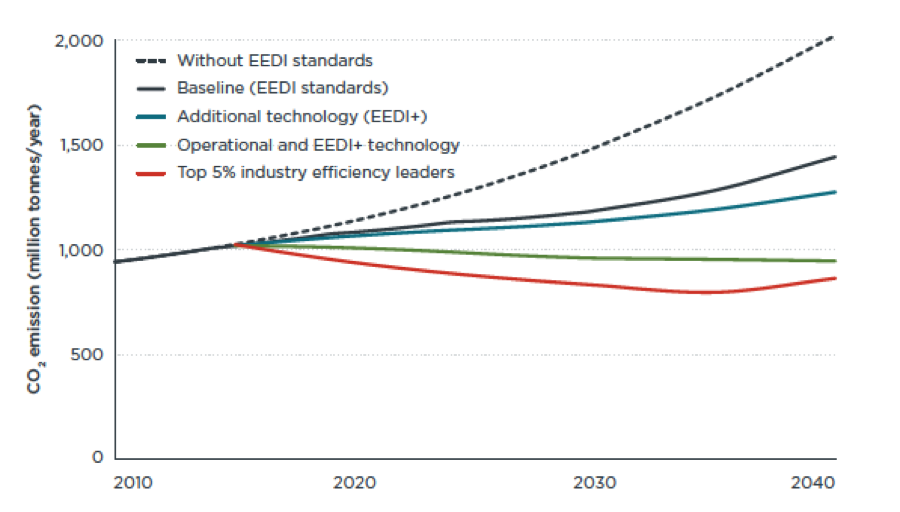Assessment of shipping’s efficiency using satellite AIS data
Blog
Is IMO losing steam on policies to reduce shipping emissions?
Last week the International Maritime Organization’s (IMO) Marine Environmental Protection Committee (MEPC) wrapped up its 67th meeting in London. It was a busy meeting, with progress on some issues, including resolutions to facilitate the entry into force of the long-delayed convention on ballast water treatment and the approval of draft safety and environmental requirements for vessels operating in Polar waters under the “Polar Code”. On climate issues, especially work on additional measures to reduce CO2 emissions from in-use vessels, less charitable things must be said.
IMO has been struggling with how to deal with climate change since the international discussions that led to the Kyoto Protocol in 1997. This dialogue has been complicated by the fact that international shipping industry can be viewed both as a problem to be solved – ships are responsible for about 11% of transportation CO2 emissions and 3% of global CO2 emissions total – and a solution of sorts, given that large ocean-going vessels are ten times as carbon efficient as heavy-duty trucks on a CO2/ton-mile basis. On balance, there are reasons for concern; according to IMO’s recently approved 3rd GHG Study, under a business as usual scenario CO2 emissions are projected to climb by between 50 and 250% by 2050 due to the increase of international trade.
A variety of policy measures, ranging from new vessel efficiency standards to market-based measures, have been considered to curb the rise of CO2 emissions from shipping. In 2011 the IMO passed the Energy Efficiency Design Index (EEDI) that requires new ships to improve their energy efficiency. The EEDI, which represented the first ever mandatory global GHG reduction regime for an entire industrial sector, is expected to reduce CO2 emissions by about 300 million metric tonnes (MMT) by 2030. However, as ships typically have a lifetime of 30 years, the EEDI will slow, not reverse, the growing trend of CO2 emissions from the industry. The potential of furthering reducing CO2 emissions – as high as 350 MMT annually by 2030 – therefore lies in the in-use ships.
Last year ICCT-sponsored and led research indicated that industry-leading ships are about twice as efficient as industry laggards, due to new ships’ technical efficiency improvements, operational speed practices, and ship size differences. For example, the top 5% of containerships have a CO2 emission intensity that is 38% lower than industry-average containerships, whereas the bottom 5% have 48% higher CO2 emissions. This in-use efficiency gap indicates a large potential to improve the efficiency of the marine sector as a whole. We estimate that fully embracing the use of class-leading CO2-intensity technology (e.g., state-of-the-art diesel engines with electronic controls) and in-use operational measures (e.g., speed reduction) could cut international shipping’s CO2 emissions roughly in half by 2040 (Figure 1), reversing the growing trajectory of shipping CO2 emissions even as global freight movement doubles.
Recognizing the importance of measures to boost in-use ship efficiency, IMO began discussing monitoring, reporting, and verification (MRV) provisions leading to mandatory in-use efficiency requirements at MEPC-62 (2011), with support building for data collection to support additional measures building slowly at each meeting through MEPC-66, held in April 2013. Unfortunately, IMO lost steam last week, in large part due to industry pushback. A coalition of industry groups argued last week that the maritime industry is overregulated and that in any event an operational efficiency standard is neither needed nor workable. This is despite the strong evidence that ships are unique in their large potential to reduce in-use emissions compared to other modes (due in part to the relationship between ship speed and efficiency discussed here) and the fact that their long useful lives mean that less efficient ships built before the EEDI took effect will remain in operation well into this century.
Ironically, these same groups widely adopted operational efficiency improvements to deal with high fuel costs and soft shipping demand after the Great Recession. IMO’s 3rd GHG study estimate that global CO2 emissions from shipping fell from 1135 MMT (3.5% of world total) in 2008 to 949 MMT (2.7%) in 2012 due to operational efficiency measures such as slow steaming. The report also predicts a return to emissions growth through the emergence of “latent emissions” when global trade catches back up to the underlying capacity and installed power of the growing shipping fleet. Now that the world economy is on the mend industry appears unwilling to continue its efficient operational practices. This suggests that IMO measures to promote operational efficiency are needed to lock in the short-term gains that industry has already made if the shipping industry is to pull its weight in efforts to protect the global climate.
Unfortunately, MEPC-67 left scant room for optimism for further progress. Little agreement was evident at the meeting on even how to collect data on operational efficiency. Many groups seemed intent on collecting the least possible amount of data (i.e. fuel consumption only) and in such a way that would prevent the kind of technical analysis needed to establish an effective measure. Member states couldn’t even agree that the data collection system should be mandatory, further increasing the risk that IMO won’t have the tools it needs to design good policy. Until MEPC-68 meets in May 2015 these details will continue to be debated in an intercessional correspondence group lacking decision-making power, raising questions whether further progress can be made.
So, the path toward on operational efficiency remains rather murky. With 2014 shaping up as the warmest year on record, one wonders when some of that heat can bring IMO’s boiler pressure back up and get discussions on operational efficiency moving back in the right direction.

